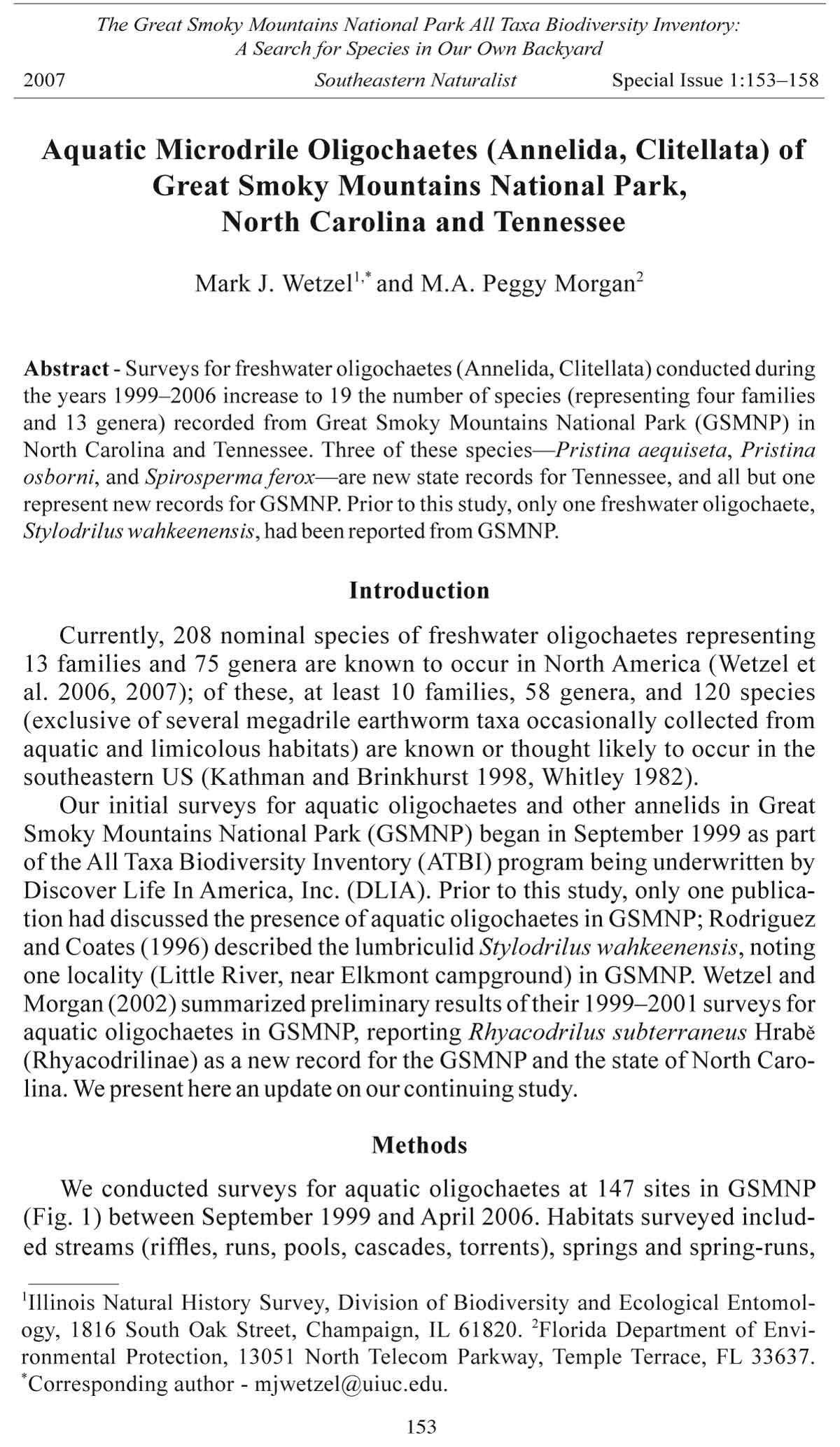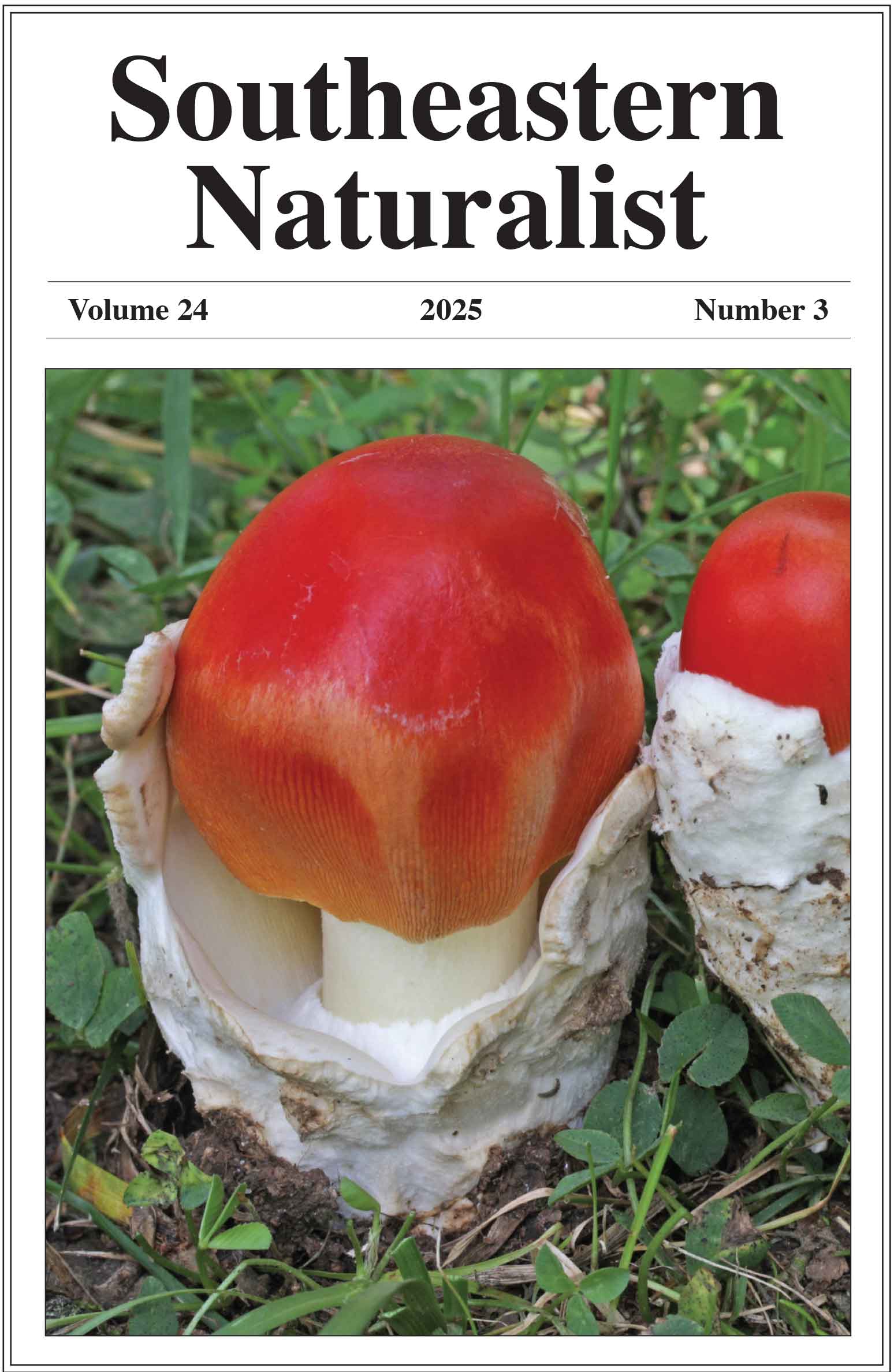1Illinois Natural History Survey, Division of Biodiversity and Ecological Entomology,
1816 South Oak Street, Champaign, IL 61820. 2Florida Department of Environmental
Protection, 13051 North Telecom Parkway, Temple Terrace, FL 33637.
*Corresponding author - mjwetzel@uiuc.edu.
Aquatic Microdrile Oligochaetes (Annelida, Clitellata) of
Great Smoky Mountains National Park,
North Carolina and Tennessee
Mark J. Wetzel1,* and M.A. Peggy Morgan2
Abstract - Surveys for freshwater oligochaetes (Annelida, Clitellata) conducted during
the years 1999–2006 increase to 19 the number of species (representing four families
and 13 genera) recorded from Great Smoky Mountains National Park (GSMNP) in
North Carolina and Tennessee. Three of these species—Pristina aequiseta, Pristina
osborni, and Spirosperma ferox—are new state records for Tennessee, and all but one
represent new records for GSMNP. Prior to this study, only one freshwater oligochaete,
Stylodrilus wahkeenensis, had been reported from GSMNP.
Introduction
Currently, 208 nominal species of freshwater oligochaetes representing
13 families and 75 genera are known to occur in North America (Wetzel et
al. 2006, 2007); of these, at least 10 families, 58 genera, and 120 species
(exclusive of several megadrile earthworm taxa occasionally collected from
aquatic and limicolous habitats) are known or thought likely to occur in the
southeastern US (Kathman and Brinkhurst 1998, Whitley 1982).
Our initial surveys for aquatic oligochaetes and other annelids in Great
Smoky Mountains National Park (GSMNP) began in September 1999 as part
of the All Taxa Biodiversity Inventory (ATBI) program being underwritten by
Discover Life In America, Inc. (DLIA). Prior to this study, only one publication
had discussed the presence of aquatic oligochaetes in GSMNP; Rodriguez
and Coates (1996) described the lumbriculid Stylodrilus wahkeenensis, noting
one locality (Little River, near Elkmont campground) in GSMNP. Wetzel and
Morgan (2002) summarized preliminary results of their 1999–2001 surveys for
aquatic oligochaetes in GSMNP, reporting Rhyacodrilus subterraneus Hrabě
(Rhyacodrilinae) as a new record for the GSMNP and the state of North Carolina.
We present here an update on our continuing study.
Methods
We conducted surveys for aquatic oligochaetes at 147 sites in GSMNP
(Fig. 1) between September 1999 and April 2006. Habitats surveyed included
streams (riffl es, runs, pools, cascades, torrents), springs and spring-runs,
153
The Great Smoky Mountains National Park All Taxa Biodiversity Inventory:
A Search for Species in Our Own Backyard
2007 Southeastern Naturalist Special Issue 1:153–158
154 Southeastern Naturalist Special Issue 1
groundwater and rock-face seeps, waterfalls, rimstone pools in Gregory
Cave, sinks, wetlands, Gum Swamp, and two domestic sewage treatment
lagoons. Specific locality information, a map designating collecting sites,
summaries of each of our collecting trips, and other information pertinent
to this study are provided via categorized hyperlinks in the site navigator
bar at the bottom of our project website (Wetzel and Morgan 2007). Habitat
characterizations and water-quality monitoring (pH, dissolved oxygen, total
dissolved solids, specific conductance, turbidity, water temperature, and
salinity) were completed at each site prior to biological sampling. Each site
was geo-referenced in the field using a GPS receiver; coordinates were then
verified against USGS topographic quadrangle maps. Throughout this study,
disturbance of collection areas was kept to a minimum, especially in highly
sensitive and finite habitats (cave, spring, spring-run, seep, and rock face);
non-target taxa were returned live to the natural environment.
Qualitative collections using D-ring dip nets (500-μm mesh) and aquarium
nets (400-μm mesh) were conducted in a variety of habitats at each site:
muck, silt, sand, gravel, cobble, boulders, sticks, branches, logs, leaf packets,
root mats, submerged and emergent aquatic plants, riparian vegetation,
and undercut banks. Each habitat was agitated by hand or foot, with dislodged
material drifting into nets. Collected materials were placed in plastic
buckets partially filled with water, then gently agitated and swirled in a
bucket (a simple elutriation process). Substrates (primarily cobble, smaller
stones, sticks, leaf packets, and other detritus) were rinsed and discarded;
the bucket's contents were then slowly strained through an aquarium net,
Figure 1. Location of sites in Great Smoky Mountains National Park (GSMNP),
North Carolina and Tennessee, where surveys for freshwater oligochaetes (Annelida,
Clitellata) were conducted by M.J. Wetzel and P. Morgan, 1999–2006. Several sites
were surveyed on more than one occasion. Sites appearing outside of the defined Park
boundary in this figure are in fact located in areas recently acquired and now under
the jurisdiction of GSMNP.
2007 M.J. Wetzel and M.A.P. Morgan 155
and the strained sample was then placed in a plastic bag or jar with a small
amount of habitat water. Unnatural substrates (bottles, cans, trash, cement,
asphalt, bricks, and tiles), although rarely encountered, were sampled and
processed in similar fashion. The elutriation and straining processes were repeated
2–3 times for each sample. Strained samples were relaxed in 5–10%
ethanol for 15–20 min, then fixed with 10% buffered formalin.
In the laboratory, samples were rinsed in tap water, drained, preserved in
80% ethanol, then stored in jars prior to sorting. Small (≈5-ml) portions of
the preserved sample were placed in 70% ethanol in a Petri dish for sorting
under a dissecting microscope. Sorted specimens were stored in 80% ethanol.
Prior to mounting on microscope slides, all small microdrile oligochaete
specimens were dehydrated in an ethanol series (80%, 95%, three washes
in absolute alcohol) then transferred to a vial with a 50/50 solution of 100%
ethanol and xylene for 1–2 hrs. Specimens were mounted in Canada balsam
on microscope slides, then placed on a slide warmer for at least five days prior
to specimen identification. Large microdriles (primarily Lumbriculidae)
and megadrile oligochaetes were retained in 80% ethanol for dissection and
identification. Slide-mounted specimens were identified using a compound
microscope equipped with Nomarski differential interference contrast optics.
Identification and nomenclature of oligochaetes followed Kathman and
Brinkhurst (1998) and literature more recently published. Additional field
and laboratory methods used during this study are presented on our project
website (Wetzel and Morgan 2007).
Results and Discussion
Nineteen aquatic oligochaete species, representing four families and 13
genera, were identified from collections in GSMNP (Table 1). Numerous
unidentified specimens were also present in our samples—primarily sexually
immature individuals representing the families Enchytraeidae and Lumbriculidae,
and occasionally the Rhyacodrilinae and Tubificinae. Specimens
representing primarily terrestrial families of earthworms occasionally found
in aquatic and limicolous habitats (Reynolds and Wetzel 2004, Wetzel et al.
2006) also were collected. Just as this paper was going to press, Steve Fend
(US Geological Survey, Menlo Park, CA) informed us that four undescribed
lumbriculid species have been found in material we had collected during this
study; three of these are athecate, and thus difficult to attribute to genus, and
the other is clearly a new genus.
With exception of Stylodrilus wahkeenensis and Rhyacodrilus subterraneus,
all taxa listed in Table 1 are new records for the Great Smoky
Mountains National Park; three—Pristina aequiseta Michaelsen, Pristina
osborni (Walton) and Spirosperma ferox Eisen—are new state records
for Tennessee. Kathman and Brinkhurst (1998) indicated that all three
of these species are considered widespread in eastern North America,
but none were specifically noted as occurring in Tennessee or the
GSMNP, and no other published papers have reported their occurrence
156 Southeastern Naturalist Special Issue 1
in Tennessee. The original description of S. wahkeenensis by Rodriguez
and Coates (1996) reported this species from Alabama, Oregon, and from
the GSMNP in Tennessee, but it has not yet been identified from samples
collected during our study. Rhyacodrilus subterraneus, first reported in
North America (New York) by Strayer and Bannon-O’Donnell (1988), has
since been reported from Illinois, Maryland, Missouri, Ohio, Tennessee,
and Virginia (Kathman and Brinkhurst 1998, Wetzel and Taylor 2001).
Table 1. Freshwater microdrile oligochaetes reported from aquatic habitats located in the Great
Smoky Mountains National Park (GSMNP), NC and TN. The symbol “+TN” indicates species being
reported here as new records for the state of Tennessee. * = Previously reported from GSMNP.
Annelida
Oligochaeta
Family Haplotaxidae
Haplotaxis cf. gordioides (Hartmann)
Family Lumbriculidae
Lumbriculus variegatus (Müller)
Stylodrilus wahkeenensis Rodriguez & Coates*
Lumbriculidae gen. sp. undet.
Family Enchytraeidae
Achaeta sp.
Enchytraeidae gen. sp. undet.
Family Naididae 1
Subfamily Naidinae
Nais behningi Michaelsen
Nais communis Piguet
Nais simplex Piguet
Nais variabilis Piguet
Paranais frici Hrabě
Slavina appendiculata (d’Udekem)
Subfamily Pristininae
Pristina aequiseta Michaelsen +TN
Pristina jenkinae (Stephenson)
Pristina leidyi Smith
Pristina osborni (Walton) +TN
Subfamily Rhyacodrilinae
Rhyacodrilus subterraneus Hrabě*
Subfamily Tubificinae
Limnodrilus hoffmeisteri Claparède
Quistadrilus multisetosus (Smith)
Tubifex tubifex (Müller)
Spirosperma ferox Eisen+TN
1Based on sequences of 18S rDNA and other molecular and morphological data, Erséus and
Gustavsson (2002) and Erséus et al. (2002) concluded that the family Naididae is more correctly
placed within a subfamily Naidinae of the Tubificidae, with “Naididae” thus becoming
a junior synonym of the family Tubificidae. A petition was then submitted by Erséus et al.
(2005) to the International Commission of Zoological Nomenclature (ICZN), requesting the
family-group name Tubificidae Vejdovský be given precedence over Naididae Ehrenberg. The
Commission recently voted against this proposal, maintaining precedence for Naididae over
Tubificidae (ICZN 2007); we adhere to this ruling. After discussions with C. Erséus (Göteberg
University, Göteberg, Sweden, pers. comm., April 2007), and pending publication of a
phylogeny contrary to that above, the subfamilies of the Tubificidae are now included within
the Naididae.
2007 M.J. Wetzel and M.A.P. Morgan 157
Wetzel and Morgan (2002) first reported the presence of R. subterraneus
in the Park and as a new state record for North Carolina.
Most of the species identified during this study (Table 1) have been
reported from a variety of aquatic habitats, and are considered to be
widespread in North America (Kathman and Brinkhurst 1998). Three
species—S. wahkeenensis, R. subterraneus, and Haplotaxis cf. gordioides
(Hartmann)—seem to be restricted to hyporheic and other groundwater
habitats, but occasionally have been collected in surface waters with
groundwater influence (Kathman and Brinkhurst 1998; Martin et al., in
press; Wetzel et al. 2006).
We consider the freshwater oligochaete fauna in GSMNP to be less
diverse than anticipated, and believe that the low diversity of freshwater oligochaetes
may be infl uenced by the lack of suitable organic matter in many
of the habitats surveyed, and the low values for both pH (range: 3.78–10.57
S.U.; mean: 6.27) and total dissolved solids (range: 0–80 mg/L; mean: 4.31).
Other water quality parameters (e.g., low water temperatures, particularly at
springs, seeps, and other habitats receiving groundwater discharge), and low
values for specific conductance and alkalinity in GSMNP (B. Nichols and
K. Langdon, National Park Service, GSMNP, Gatlinburg, TN, pers. comm.)
also could be limiting factors.
Scheduled work on this continuing study will include collections from
several sites during 2008, identification of recently collected specimens,
collaboration with other oligochaetologists on problematical taxa requiring
further diagnostic study, and analyses of the relationship between oligochaetes
and environmental parameters through ordination analysis.
Acknowledgments
Numerous DLIA, ATBI, and GSMNP personnel have provided support, advice,
and encouragement throughout our involvement in this research; in particular, we
thank J. Hilten, J. Morse, P. White, K. Langdon, B. Nichols, C. Parker, R. Shifl ett,
K. Fitz Patrick, S. Sachs, P. Super, K. Voorhis, C. Cooper, M. Kunze, and P. Cox.
We extend our appreciation to B. and P. Stetler, B. and J. Froyd, L. Domingue, W.
Reeves, R. Brinkhurst, and many oligochaete colleagues for their assistance, hospitality,
encouragement, and scientific guidance throughout this project. Funding and
institutional support for this study was provided by several mini-grants from DLIA
and the Illinois Natural History Survey. We also thank D. Webb, S. Taylor, S. Fend,
R.D. Kathman, and an anonymous reviewer for valuable critiques of this paper, and
S. Taylor for assistance with ArcGIS to create the map in this paper. All fieldwork
in GSMNP was conducted under the following permits issued by the National Park
Service: GSMNP-99-124, GSMNP-00-133, GSMNP-2001-SCI-0094, GSMNP-
2002-SCI-0015, and GSMNP-2005-SCI-0020.
Literature Cited
Erséus, C., and L. Gustavsson. 2002. A proposal to regard the former family Naididae as
a subfamily within Tubificidae (Annelida, Clitellata). Hydrobiologia 485:253–256.
158 Southeastern Naturalist Special Issue 1
Erséus, C., M. Källersjö, M. Ekman, and R. Hovmöller. 2002. 18S rDNA phylogeny
of the Tubificidae (Clitellata) and its constituent taxa: Dismissal of the Naididae.
Molecular Phylogenetics and Evolution 22(3):414–422.
International Commission on Zoological Nomenclature (ICZN). 2007. Opinion 2167
(Case 3305). Naididae Ehrenberg, 1828 (Annelida, Clitellata): Precedence over
Tubificidae Vejdovský, 1876 maintained. Bulletin of Zoological Nomenclature
64:71–72.
Kathman, R.D., and R.O. Brinkhurst. 1998. Guide to the Freshwater Oligochaetes of
North America. Aquatic Resources Center, College Grove, TN. 264 pp.
Martin, P., E. Martinez-Ansemil, A. Pinder, T. Timm, and M.J. Wetzel. In Press. A
global assessment of the oligochaetous clitellate diversity in freshwater. In E.V.
Balian, C. Lévêque, C.,H. Segers, and K. Martens (Eds.). Freshwater Animal
Diversity Assessment. Hydrobiologia.
Reynolds, J.W., and M.J. Wetzel. 2004. Terrestrial Oligochaeta (Annelida: Clitellata)
in North America north of Mexico. Megadrilogica 9:71–98.
Rodriguez, P., and K.A. Coates. 1996. A new American Stylodrilus species (Lumbriculidae,
Oligochaeta). Canadian Journal of Zoology 74:92–96.
Strayer, D., and E. Bannon-O’Donnell. (1988). Aquatic microannelids (Oligochaeta
and Aphanoneura) of underground waters of southeastern New York. American
Midland Naturalist 119:327–335.
Wetzel, M.J., and P. Morgan. 2002. Aquatic Oligochaeta (Annelida, Clitellata) of the
Great Smoky Mountains National Park, North Carolina and Tennessee. Southeastern
Biology 49:389–392.
Wetzel, M.J., and P. Morgan. 2007. The Aquatic Oligochaeta (Annelida, Clitellata)
of the Great Smoky Mountains National Park, North Carolina and Tennessee,
USA. Available online at http://www.inhs.uiuc.edu/~mjwetzel/AOGSMNP.
home.html. Accessed 27 September 2007.
Wetzel, M.J., and S.J. Taylor. 2001. First records of freshwater oligochaetes (Annelida,
Clitellata) from caves in Illinois and Missouri, USA. Journal of Cave and
Karst Studies 63:99–104.
Wetzel, M.J., S.V. Fend, K.A. Coates, R.D. Kathman, and S.R. Gelder. 2006. Taxonomy,
Systematics, and Ecology of Aquatic Oligochaeta and Branchiobdellidae
(Annelida, Clitellata) of North America, with Emphasis on the Fauna Occurring
in Florida. A workbook prepared for a 3-day workshop presented to Florida
Department of Environmental Protection Personnel, 21–23 February 2006, Tallahassee,
F; updated copies available from the senior author (mjwetzel@uiuc.
edu). 269 pp.
Wetzel, M.J., R.D. Kathman, S.V. Fend, and K.A. Coates. 2007. Classification and
checklist of the freshwater Oligochaeta occurring in North America north of
Mexico. Available online at http://www.inhs.uiuc.edu/~mjwetzel/FWOligo-
NAChklst.html. Accessed 27 September 2007.
Whitley, L.S. 1982. Aquatic Oligochaeta. Pp. 2.1–2.29, In A.R. Brigham, W.U.
Brigham, and A. Gnilka (Eds.). Aquatic Insects and Oligochaetes of North and
South Carolina. Midwest Aquatic Enterprises, Mahomet, IL. 837 pp.














 The Southeastern Naturalist is a peer-reviewed journal that covers all aspects of natural history within the southeastern United States. We welcome research articles, summary review papers, and observational notes.
The Southeastern Naturalist is a peer-reviewed journal that covers all aspects of natural history within the southeastern United States. We welcome research articles, summary review papers, and observational notes.